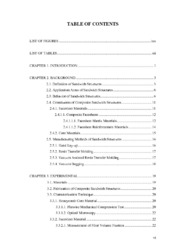Please use this identifier to cite or link to this item:
https://hdl.handle.net/11147/3947Full metadata record
| DC Field | Value | Language |
|---|---|---|
| dc.contributor.advisor | Tanoğlu, Metin | - |
| dc.contributor.author | Sezgin, Fatma Erinç | - |
| dc.date.accessioned | 2014-07-22T13:52:48Z | - |
| dc.date.available | 2014-07-22T13:52:48Z | - |
| dc.date.issued | 2008 | - |
| dc.identifier.uri | http://hdl.handle.net/11147/3947 | - |
| dc.description | Thesis (Master)--Izmir Institute of Technology, Mechanical Engineering, Izmir, 2008 | en_US |
| dc.description | Includes bibliographical references (leaves: 62-64) | en_US |
| dc.description | Text in English; Abstract: Turkish and English | en_US |
| dc.description | xii, 64 leaves | en_US |
| dc.description.abstract | The use of composite sandwich structures is increasing in aerospace and civil infrastructure applications due to their high flexural and transverse stiffness and light weight. Considering different mechanical properties, sandwich structures can be manufactured from various core and facesheet materials.In this study, hand lay up technique was used for the fabrication of sandwich structures made of polypropylene based honeycomb core and glass fiber reinforced polymer (GFRP) facesheets. The non-crimp glass fibres and epoxy matrix were used for the production of GFRP laminates. The variation of the core thickness was the major parameter for considering the mechanical behaviour and failure mechanisms of the sandwich structures. Based on flatwise compression tests, an increase in compressive modulus and strength was observed with the increase of core thickness. For edgewise compression tests, peak loads up to crush of the sandwich panel was discussed by means of core thickness. According to the three point bending tests, a decrease in core shear stress and facesheet bending stress was observed as the core thickness increases.The modeling of sandwich structures were also carried out with three dimensional finite element models. The ANSYS 11 software was used for utilizing the test data in order to predict the mechanical behavior of the sandwich structures. In the finite element analysis, the test results of each constituent were employed as the input data for ANSYS. The experimental data and predicted results were found to be in good agreement in the elastic region, therefore the model can be used to predict the behavior of similar structures in elastic region. | en_US |
| dc.language.iso | en | en_US |
| dc.publisher | Izmir Institute of Technology | en_US |
| dc.rights | info:eu-repo/semantics/openAccess | en_US |
| dc.subject.lcc | TA660.S3 .S522 2008 | en |
| dc.subject.lcsh | Sandwich construction | en |
| dc.subject.lcsh | Honeycomb construction | en |
| dc.title | Mechanical Behavior and Modeling of Honeycomb Cored Laminated Fiber/Polymer Sandwich Structures | en_US |
| dc.type | Master Thesis | en_US |
| dc.institutionauthor | Sezgin, Fatma Erinç | - |
| dc.department | Thesis (Master)--İzmir Institute of Technology, Mechanical Engineering | en_US |
| dc.relation.publicationcategory | Tez | en_US |
| dc.identifier.wosquality | N/A | - |
| dc.identifier.scopusquality | N/A | - |
| item.openairecristype | http://purl.org/coar/resource_type/c_18cf | - |
| item.languageiso639-1 | en | - |
| item.openairetype | Master Thesis | - |
| item.grantfulltext | open | - |
| item.fulltext | With Fulltext | - |
| item.cerifentitytype | Publications | - |
| Appears in Collections: | Master Degree / Yüksek Lisans Tezleri | |
Files in This Item:
| File | Description | Size | Format | |
|---|---|---|---|---|
| T000703.pdf | MasterThesis | 2.15 MB | Adobe PDF |  View/Open |
CORE Recommender
Page view(s)
434
checked on Mar 31, 2025
Download(s)
564
checked on Mar 31, 2025
Google ScholarTM
Check
Items in GCRIS Repository are protected by copyright, with all rights reserved, unless otherwise indicated.